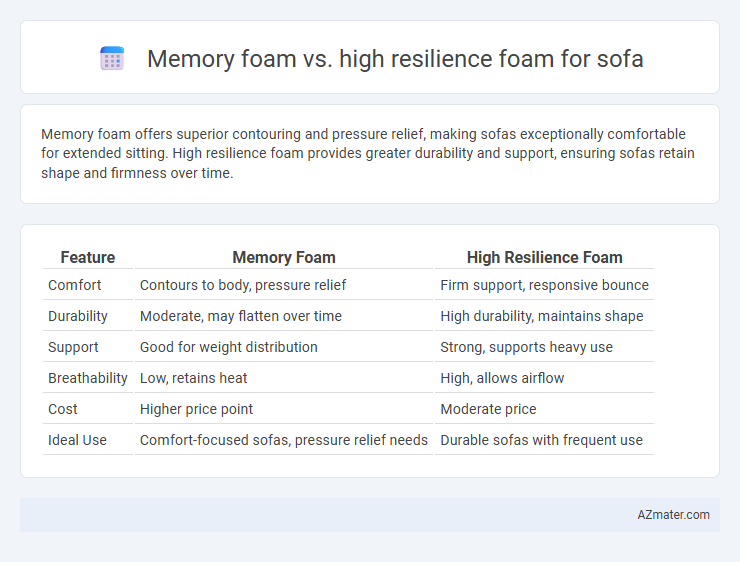Memory foam offers superior contouring and pressure relief, making sofas exceptionally comfortable for extended sitting. High resilience foam provides greater durability and support, ensuring sofas retain shape and firmness over time.
Table of Comparison
| Feature | Memory Foam | High Resilience Foam |
|---|---|---|
| Comfort | Contours to body, pressure relief | Firm support, responsive bounce |
| Durability | Moderate, may flatten over time | High durability, maintains shape |
| Support | Good for weight distribution | Strong, supports heavy use |
| Breathability | Low, retains heat | High, allows airflow |
| Cost | Higher price point | Moderate price |
| Ideal Use | Comfort-focused sofas, pressure relief needs | Durable sofas with frequent use |
Introduction to Sofa Cushion Foams
Memory foam offers superior contouring and pressure relief, enhancing comfort by adapting closely to body shape. High resilience foam provides excellent durability and support with its responsive and resilient structure, maintaining shape over time. Both foams are popular choices for sofa cushions, catering to different preferences in firmness and longevity.
What is Memory Foam?
Memory foam is a viscoelastic material known for its pressure-relieving properties and ability to conform to body shape, providing superior comfort and support in sofas. It responds to heat and pressure by softening and molding to the user's body, which helps distribute weight evenly and reduce pressure points. Compared to high resilience foam, memory foam offers enhanced contouring but may retain more heat and have a slower response time when returning to its original shape.
What is High Resilience (HR) Foam?
High Resilience (HR) foam is a type of polyurethane foam known for its superior durability, elasticity, and support compared to standard foam. It offers excellent resilience, meaning it quickly regains its shape after compression, making it ideal for sofas subjected to frequent use. HR foam provides a firm yet comfortable seating experience, ensuring long-lasting comfort and maintaining sofa structure over time.
Comfort and Support Comparison
Memory foam offers superior contouring comfort by adapting closely to body shape, providing pressure relief ideal for prolonged sitting. High resilience foam delivers robust support with excellent bounce-back properties, maintaining sofa shape while supporting body weight evenly. Combining memory foam's cushioning and high resilience foam's durability can optimize both comfort and structural integrity in sofa cushions.
Durability and Longevity
High resilience foam offers superior durability with its high rebound rate and strong support, making it ideal for sofas that endure frequent use. Memory foam provides excellent comfort by contouring to the body but tends to break down faster under constant pressure, reducing overall longevity. For long-term sofa durability, high resilience foam outperforms memory foam in maintaining shape and preventing sagging over time.
Pressure Relief Capabilities
Memory foam offers superior pressure relief by conforming closely to body contours, distributing weight evenly to reduce stress points and enhance comfort. High resilience foam provides moderate pressure relief through its responsive and supportive structure, maintaining durability and quick recovery after compression. Choosing memory foam is ideal for those prioritizing pressure alleviation, while high resilience foam balances comfort with long-term support.
Breathability and Heat Retention
Memory foam offers superior contouring comfort but tends to retain heat due to its dense cell structure, reducing breathability and potentially causing discomfort in warm environments. High resilience foam features an open-cell design that promotes better airflow, enhancing breathability and minimizing heat retention for a cooler seating experience. Choosing high resilience foam for sofa cushions is ideal in climates or for users prioritizing temperature regulation and ventilation.
Cost Differences and Value
Memory foam typically costs more than high resilience foam due to its superior pressure relief and contouring properties, offering enhanced comfort and durability. High resilience foam provides excellent support and resilience at a lower price point, making it a cost-effective choice for budget-conscious consumers seeking longevity. Evaluating the trade-off between upfront cost and long-term comfort can help determine the best foam type for sofa cushions based on individual value preferences.
Best Use Cases for Each Foam Type
Memory foam excels in contouring to body shape, making it ideal for sofas designed for prolonged sitting and enhanced comfort, such as in living rooms or home theaters. High resilience foam offers superior durability and support, making it best suited for frequently used sofas in busy households or commercial settings where longevity and bounce-back are essential. Choosing between the two depends on whether comfort and pressure relief (memory foam) or firm support and resilience (high resilience foam) are prioritized.
Which Foam is Right for Your Sofa?
Memory foam offers superior contouring and pressure relief, ideal for sofas prioritizing comfort and support for extended sitting. High resilience foam provides excellent durability and bounce, making it suitable for sofas that require long-lasting firmness and shape retention. Choosing the right foam depends on whether softness and body adaptation or resilience and structural support are the primary needs for your sofa.

Infographic: Memory foam vs High resilience foam for Sofa
 azmater.com
azmater.com